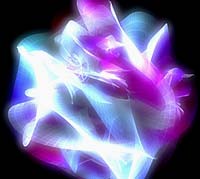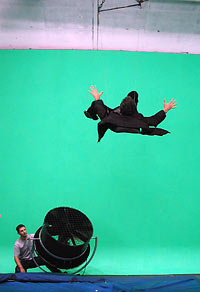An Especially Elegant Universe
Joe McMaster, producer, director, and writer of Nova's The Elegant Universe, is not a physicist. Fortunately, he had the patient help of the show's star and narrator, physicist Brian Greene, as he put together the PBS production delving into String Theory. “Brian was great,” says McMaster, “No matter what question we asked him, he was always able to explain things in ways that made it clear even to me.” An impressive feat, considering the fact that String Theory is one of the most mathematically intense fields in contemporary physics.
What: Nova's The Elegant Universe
When: Premieres Oct. 28, 2003
Where: Your local PBS station
Who: Brian Greene

A Calabi-Yau shape: a two dimensional visualization of the six additional spatial dimensions required by string theory. (Image courtesy of NOVA)

Attached to wires and blown by a wind machine, Brian Greene “flies” through the air against a green screen background, which will be replaced in the editing process by footage of a city street scene. (Photo by Andrea Cross for WGBH)
McMaster relied heavily on Greene's book, also titled The Elegant Universe, throughout the production of the program, which was filmed on locations ranging from downtown Manhattan to a piano factory to the desert of New Mexico. “A lot of the shots were pretty obvious adaptations of the imagery in Brian's book. But for others we would sit around and brainstorm,” says McMaster, “you know we'd ask 'How can we visualize this concept or the other?' And I think we were able to come up with some pretty creative answers.”
Much of the program, explains McMaster, required intense cooperation of camera crews and computer experts who melded live action shots with sound stage footage and animation. Some, like a shot of an ant exploring the surface of an electrical cable strung across a Manhattan thoroughfare, were high-tech interpretations of illustrations straight out of Greene's book. Others required decidedly low-tech, on-the-spot improvisation. “When we were filming at White Sands,” says McMaster, “we wanted to show how an attractive force could be demonstrated by two people throwing a baseball back and forth.” The result was a scene in which Greene apparently plays a game of catch with himself. With each toss, the two Brian Greene's are dragged closer together on the fine, white gypsum sand of the desert park at White Sands National Monument. “There's a shot of Brian's feet as he's being pulled by these forces we were trying to demonstrate. To get it, we sort of hung Brian from a ladder - I was on one end - and we just dragged him along and filmed his feet as we went.”
Many of the most striking images in the program, however, required Greene to recite his lines on an empty sound stage, with animation added later. For one segment, the crew even suspended Greene on wires over a wind machine to simulate the intrepid physicist in flight. “Fortunately, Brian is a gifted performer. He'd go over his lines, and we'd film it a few times trying different inflections. But he's a natural talent. Not at all like you'd expect from your typical Ph.D. physicist,” chuckles McMaster.
Almost as impressive as the trick photography are the surprisingly lucid performances McMaster was able to coax out of a host of renowned physicists whose interviews pepper the program. To keep their comments at a level appropriate for general audiences, McMaster conducted the interviews himself rather than involving Greene. “We felt that if they spoke to me,” says McMaster, “instead of another physicist, then their remarks would be more accessible to people at large.”
Despite the fact that McMaster considers himself an “artistic type,” with little talent for physics or mathematics, it's clear from his descriptions of the multi-dimensional universes, quantum fluctuations, and gravitational wells depicted in the program that his work on the show has given him a profound, intuitive appreciation of String Theory. It's an appreciation that he hopes to impart to PBS viewers when The Elegant Universe begins airing October 28. Now that the production is complete, what does McMaster have in mind for the future? “First,” says McMaster, “I'm going to take a long vacation.”














